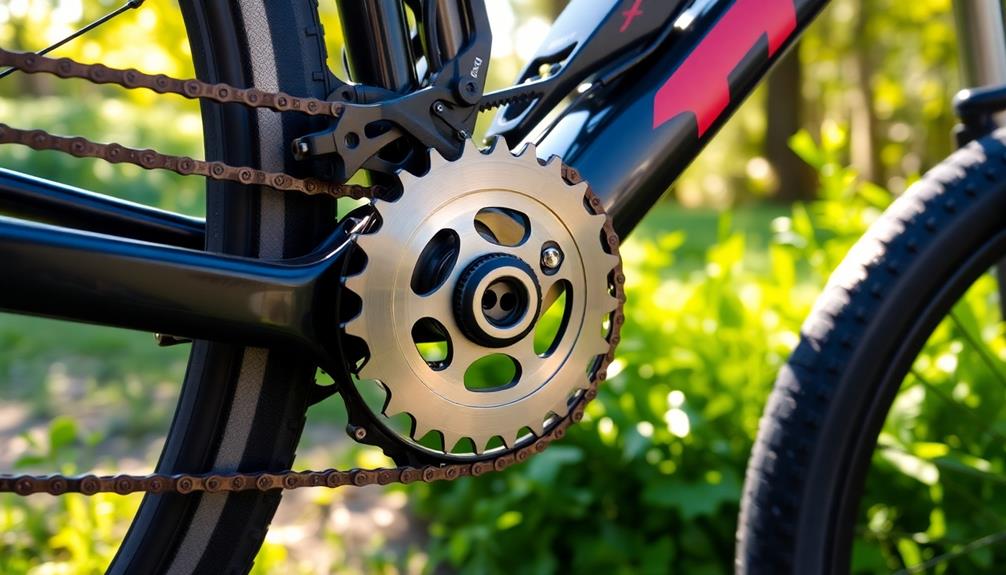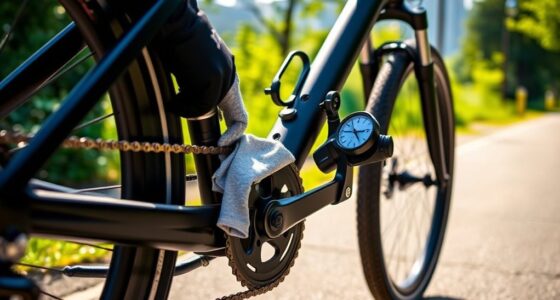The right tires for your hybrid bike can greatly impact both your speed and comfort. Wider tires, typically between 35mm and 45mm, provide better grip and shock absorption, enhancing your ride on mixed terrains. Proper inflation also plays an essential role; maintaining a pressure around 70-80 PSI can balance comfort and performance. Tubeless tires offer even more advantages, reducing the risk of flats while allowing for lower pressures. Ultimately, your tire choice shapes your cycling experience, so considering all factors can lead to smoother, faster rides. Explore further to uncover more insights on optimizing your bike's performance!
Key Takeaways
- Tire width significantly affects comfort; wider tires (35mm to 45mm) enhance shock absorption and ride smoothness on varied terrains.
- Proper tire inflation (70-80 PSI) maximizes performance and comfort, balancing speed and shock absorption based on conditions.
- Tubeless tires reduce flat risks and allow for lower pressures, improving ride quality and comfort on rough surfaces.
- Tread patterns influence traction and control, enhancing speed and stability across both paved and gravel paths.
- Budget considerations are important; investing in quality tires improves durability and overall cycling experience on hybrid bikes.
Importance of Tire Selection
When it comes to hybrid bikes, tire selection plays a critical role in your overall riding experience. The right tires can greatly impact both speed and comfort. Generally, wider tires in the range of 35mm to 45mm provide a cushioned ride, enhancing grip and stability on mixed terrains, while also smoothing out uneven surfaces.
However, keep in mind that wider tires may increase rolling resistance, which could affect your speed. Additionally, using the right tire pressure can maximize performance, similar to how electric dirt bikes benefit from proper maintenance for improved speed and handling.
Tire pressure is another essential factor. Lower pressures improve shock absorption, making for a more enjoyable ride, but higher pressures can boost your speed at the cost of comfort. So, striking the right balance is important.
Moreover, selecting tires with appropriate tread patterns based on your intended terrain can enhance your traction and control, further improving your cycling performance on both paved and unpaved roads.
Lastly, maintaining proper tire size, fit, and inflation is critical for maximizing your hybrid bike's performance. By paying attention to these elements, you can guarantee an ideal balance between speed and rider comfort, making every ride more enjoyable and efficient.
Types of Hybrid Bike Tires

Choosing the right type of hybrid bike tire can greatly enhance your riding experience across various terrains. Hybrid bike tires typically range from 35mm to 45mm in width, striking a balance between speed and comfort. The most common diameter for these tires is 700c (622mm), which suits a wide variety of bike frames and riding styles.
Additionally, selecting tires with ideal durability and grip can mirror the satisfaction seen in users of high-quality vacuum pool cleaners, highlighting the importance of thoughtful equipment choice.
You'll find that hybrid tires often feature a versatile tread pattern, designed to perform well on both paved roads and gravel surfaces. This adaptability allows you to confidently tackle different terrains without sacrificing performance.
The construction of these tires can also vary, with options like tubeless tires that reduce the risk of flats and improve ride quality. Tubeless tires work particularly well with lower inflation pressures, giving you a smoother ride by absorbing shocks from uneven terrain.
Ultimately, choosing the right hybrid bike tire can greatly affect your speed and comfort on rides. By considering factors like width, diameter, and tread pattern, you'll be better equipped to select tires that suit your specific needs and enhance your overall cycling experience.
Tire Width and Comfort
Tire width greatly impacts your comfort on a hybrid bike, especially as you navigate varied terrains. Choosing wider tires, typically ranging from 35mm to 45mm, enhances your riding experience by increasing the contact area with the ground. This larger surface area considerably improves shock absorption, allowing you to glide smoothly over bumps and uneven surfaces.
Additionally, maintaining proper tire pressure is vital for ideal performance, much like ensuring water requirements for extra-large houseplants align with their size and environment. While you might find that increasing tire width from 25mm to 28mm offers some comfort benefits, the advantages truly shine with wider tires. Properly inflated wider tires let you run lower pressure settings, which further enhances ride comfort. This combination allows for a cushioned experience, making hybrid bikes ideal for mixed terrain riding, where comfort takes precedence.
When you prioritize your cycling needs, consider how wider tires can accommodate various surfaces. You'll discover that these tires not only provide a smoother ride on well-paved roads but also handle rougher terrain with ease.
Ultimately, the right tire width can make all the difference in ensuring you enjoy every mile you ride, keeping your comfort at the forefront of your cycling adventures.
Inflation Pressure Effects

When it comes to tire inflation pressure, finding the right balance can make a big difference in your ride.
Proper tire pressure not only enhances speed but also contributes to overall comfort, much like how color accuracy in projectors impacts image quality.
You'll want to take into account how comfort and performance interact, especially if you're riding on various surfaces.
Experimenting with ideal pressure levels can help you achieve that sweet spot for a smoother experience.
Optimal Pressure Levels
Achieving the right tire pressure is essential for maximizing comfort and performance on your hybrid bike. Following standard recommendations, you should aim for around 80 PSI in the rear tire and 70 PSI in the front, especially if you weigh about 155 lbs. However, don't hesitate to adjust based on your unique cycling experience.
A well-maintained tire can greatly enhance your overall cycling experience and support the versatility of your hybrid bike, allowing it to perform well on various terrains, including roads and light trails commuting efficiency.
Consider these key points when determining ideal pressure levels:
- Lowering tire pressure can greatly enhance ride comfort by absorbing shocks.
- Over-inflated tires lead to harsher rides, increasing rolling resistance.
- Maintaining correct tire pressure improves speed by ensuring better ground contact.
- Experimenting with tire pressure using calculators can help you find the perfect balance.
When you inflate your tires to the proper levels, you not only boost ride comfort but also achieve ideal performance.
Lower air pressure can soften your ride, particularly on uneven surfaces, while higher pressure may hinder speed and handling. By paying attention to tire pressure, you can enjoy a smoother, more efficient cycling experience.
Comfort vs. Performance
Finding the right balance between comfort and performance is essential for an enjoyable ride on your hybrid bike. Proper tire inflation directly influences this balance. When you lower tire inflation pressure, you enhance ride comfort by reducing shocks from uneven terrain and minimizing hand strain. However, pushing the pressure too high can lead to a harsh experience and increased rolling resistance, impacting your speed and responsiveness.
Experimenting with different pressures helps you find your sweet spot. Wider tires can better conform to the road surface, improving traction and comfort without sacrificing performance. Here's a quick overview of how different inflation pressures can affect your ride:
| Tire Pressure (PSI) | Comfort Level | Performance Level |
|---|---|---|
| 60 | High | Moderate |
| 70 | Moderate | Good |
| 80 | Low | Excellent |
| 90 | Very Low | Poor |
| 100 | Minimal | Very Poor |
Maintaining proper tire inflation not only enhances your ride comfort but also influences your overall biking performance, making regular pressure checks a must for all hybrid bike riders.
Tubeless vs. Standard Tires

Deciding between tubeless and standard tires for your hybrid bike can greatly impact your riding experience. Tubeless tires offer several advantages that can enhance your ride quality, especially when traversing rough terrains.
Not only do they provide better traction and comfort, but they also can be more efficient with lower rolling resistance, similar to how geothermal heat pumps achieve impressive efficiency ratings by utilizing the Earth's stable temperature for heating and cooling, resulting in significant energy savings energy savings of 30% to 70%.
Here's what you can expect when choosing tubeless over standard tires with inner tubes:
- Lower rolling resistance: Tubeless tires typically provide improved speed and efficiency on your rides.
- Enhanced comfort: Without inner tubes, you can run lower tire pressures, which helps absorb bumps and uneven surfaces better.
- Improved grip: Riders often report better traction, making long-distance rides more enjoyable.
- Fewer pinch flats: The tubeless system reduces the risk of flats, offering a more reliable ride.
While installing tubeless tires might require additional equipment like tubeless-compatible rims and sealant, the benefits often outweigh the setup effort.
You'll likely notice a significant difference in ride quality, with many riders praising the enhanced grip and comfort they experience.
If you're looking to boost your hybrid bike's performance and comfort, tubeless tires could be the perfect choice for your next adventure.
Budget Considerations in Tire Choice

When you're choosing tires for your hybrid bike, balancing cost and quality is essential.
While higher-priced tires often offer better performance and comfort, there are plenty of affordable options that still provide a satisfying ride.
For instance, understanding the importance of GMC tuning techniques can be analogous to selecting the right tire for peak performance.
You can maximize comfort even on a budget by considering wider tires and maintaining proper inflation.
Cost Versus Quality Trade-Off
Choosing the right tires for your hybrid bike often comes down to balancing cost and quality. While higher quality tires typically offer better performance and comfort, they also come with a heftier price tag.
As a budget-conscious rider, you'll want to evaluate how much you're willing to invest in your cycling experience. It's similar to selecting the best dog food for allergies where you weigh the benefits of premium options against your budget.
Here are some key points to keep in mind:
- Wider tires can improve comfort by absorbing shocks on varied terrains, even if they cost slightly more.
- Mid-range tires provide satisfactory comfort levels but may sacrifice some performance compared to premium options.
- Lower-priced tires might seem appealing initially but can lead to increased rolling resistance and decreased durability, affecting long-term cycling performance.
- Higher quality tires tend to reflect superior construction and materials, enhancing both speed and comfort.
Ultimately, understanding the cost versus quality trade-off will help you make an informed decision.
Investing wisely can enhance your ride, so weigh your options carefully. Remember, it's not just about saving money today; it's about ensuring a comfortable and enjoyable cycling experience in the long run.
Affordable Comfort Options
Finding affordable comfort options for your hybrid bike tires doesn't have to mean settling for subpar quality. By selecting tires with a width of 35mm to 45mm, you can greatly enhance your ride's comfort without sacrificing speed.
Wider tires provide better shock absorption on uneven surfaces, making your cycling experience much smoother. Additionally, considering the average costs of home security systems can help you budget effectively for other cycling accessories.
Look for cost-effective tire options from reputable brands that feature tread designs balancing grip and rolling resistance. Investing between $30 and $60 for decent quality hybrid tires pays off in durability and comfort, avoiding the harsh ride associated with cheaper alternatives.
Experimenting with inflation pressure can also lead to comfort improvements. For hybrid bikes, a recommended range of 70-80 PSI allows for a customized fit; slightly lowering the pressure can enhance ride quality without compromising performance.
Additionally, consider tubeless tires as an affordable option. They not only reduce the chances of pinch flats but also enable lower inflation pressures, contributing to a more enjoyable ride.
Frequently Asked Questions
What Is the Best Tire Pressure for a Hybrid Bike?
To find the best tire pressure for your hybrid bike, start around 50 PSI for 700x35c tires if you weigh 155 lbs. Adjust based on comfort and terrain, aiming for a balance between performance and ride quality.
Does Bike Tire Pressure Affect Speed?
Ever felt the wind rush past you? Bike tire pressure definitely affects speed. Proper inflation reduces drag, helping you glide effortlessly. So, keep those tires inflated and experience the thrill of faster rides!
What Size Wheels Are Best for Hybrid Bikes?
When choosing wheels for your hybrid bike, consider a 700c diameter with widths between 35mm to 45mm. This size balances speed and comfort, ensuring stability and traction on both paved and unpaved surfaces.
Can I Put Wider Tires on My Hybrid Bike?
Yes, you can put wider tires on your hybrid bike, but check your bike's specifications first. Wider tires improve comfort and stability, especially on rough terrain, though they may slightly increase rolling resistance.
Conclusion
Choosing the right tires for your hybrid bike can transform your ride experience. Imagine gliding effortlessly over a smooth path, feeling the perfect balance between speed and comfort. While some might argue that all tires are the same, the right selection can mean the difference between a bumpy journey and a seamless adventure. Don't settle for less; invest in tires that enhance your performance, boost your confidence, and make every ride a pleasure. Your bike deserves it!
















